Dueling Spectrum Charts
Like the “dueling banjos” scene in Deliverance, we now have dueling spectrum charts with the release this week of the FCC White Paper The Mobile Broadband Spectrum Challenge: International Comparisons, produced jointly by WTB and OET.
Reader may recall the recent criticism here of CTIA’s long used chart shown below:
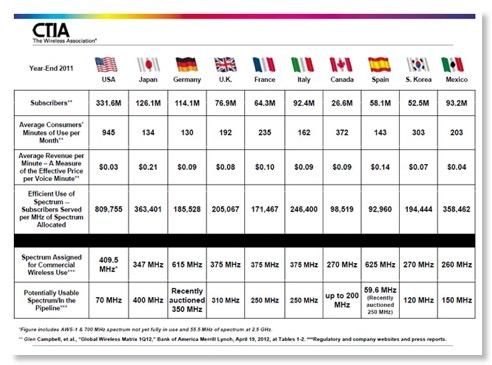
Now FCC has answered back with its own accounting of international mobile spectrum use:
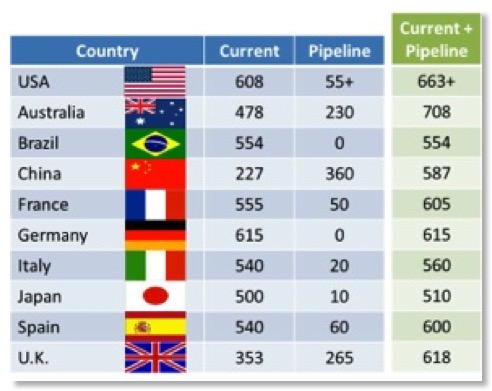
Now FCC does not use the absurd CTIA metric of “subscribers served per MHz of spectrum allocated” previously discussed here. And FCC adds data on unlicensed spectrum, often used by the cellular establishment for offloading traffic and thus improving service but almost always opposed by the cellular industry.
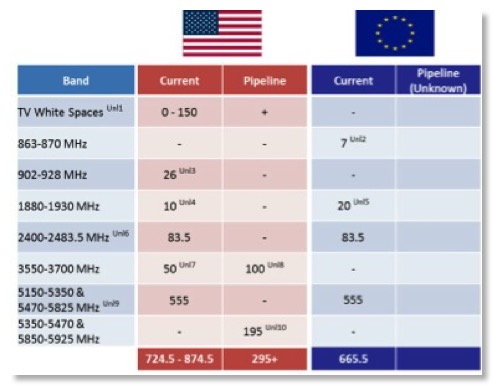
Clearly there are some major difference between CTIA’s accounting and FCC’s. For example FCC finds 608 MHz of “mobile broadband” spectrum now in the US, while CTIA can only find 409.5 MHz of “spectrum assigned for commercial wireless use”. At least in the UK the numbers are closer, FCC finds 353 MHz while CTIA finds 375 MHz. In the case of Japan, FCC finds 500 MHz of spectrum while CTIA can only find 347 MHz.
Hopefully both sides will explain what exactly they added up to get to the bottom of this disagreement. However, in the country with the world’s largest most information intensive military and with a severe post 9/11 public safety problem, it should not be surprising that less spectrum is available for commercial wireless then in, say, Brazil. If the cellular community was more open to spectrum sharing, rather than just trashing the PCAST report sharing recommendations, we could have more commercial wireless use as well as public safety/defense use.
SECDEF Hagel & Cellular Industry
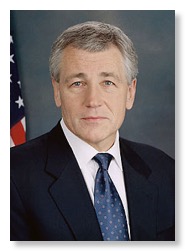
The Senate has confirmed military and wireless industry veteran Chuck Hagel as the next Secretary of Defense.
Hagel was a co-founder of Vanguard Cellular systems. At one time, Vanguard was the largest independent wireless carrier and was eventually bought by AT&T Wireless in 1999.
A little Googling revealed:
- “He left the Army in 1968 with the rank of sergeant. Hagel later co-founded Vanguard Cellular in 1984. The money he earned from the cellular carrier allowed him to enter politics on the national stage.” Military.com
- “After the war, he worked his way through the University of Nebraska in Omaha, then got a job in the office of Rep. John McCollister, R-Neb. He rose to administrative assistant; after McCollister lost a Senate race in 1976, Hagel became a lobbyist for Firestone. He later got the Number 2 position in the Reagan Veterans’ Affairs Administration, but resigned after only one year. Hagel then founded Vanguard Cellular Systems, which became the second largest cell phone company in the nation.” National Journal
Equipment Authorization NPRM: 1st Comments Deal with Enforcement
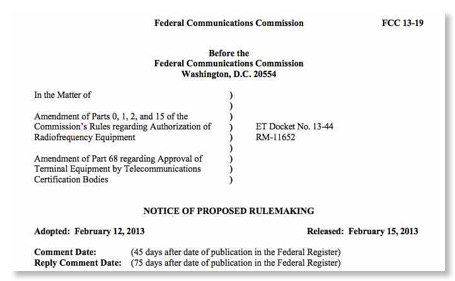 Today the comments of Marcus Spectrum Solutions LLC in the Equipment Authorization Rulemaking, Docket 13-44, were posted on the Commission’s comment website, ECFS. These comments were the first filed and were filed early in an attempt to raise a key issue in this proceeding: the enforcement mechanism of rules must be credible in order to deter the introduction of noncompliant equipment into the US wireless market. The present equipment authorization rules are outdated and lack credibility with respect to enforcement because of changes in both the marker for wireless equipment and the technology used today.
Today the comments of Marcus Spectrum Solutions LLC in the Equipment Authorization Rulemaking, Docket 13-44, were posted on the Commission’s comment website, ECFS. These comments were the first filed and were filed early in an attempt to raise a key issue in this proceeding: the enforcement mechanism of rules must be credible in order to deter the introduction of noncompliant equipment into the US wireless market. The present equipment authorization rules are outdated and lack credibility with respect to enforcement because of changes in both the marker for wireless equipment and the technology used today.The real threat of continuing the current basic structures is twofold:
- Noncompliant equipment’s market share could increase and discourage compliance by legitimate manufacturers due to both price pressure and rapid copying of legitimate equipment.
- Noncompliant equipment could cause the very interference problems that the Commission’s Title III rules were designed to prevent!
The comments suggest changes in 4 areas:
- Criminalize the submission of fraudulent postmarket samples. FCC has never taken serious action against manufactures/imported who submit doctored samples.
- Codify key terms of KDB Publication No. 610077 and increase post-market sampling rate of TCBs. This obscure publication includes key requirements for TCBs to sample equipment on the market. Sampling should be increased above the present 5% and the requirements should be codified in the FCC Rules to make them clear to all
- Address TCBs’ basic conflict in post-market testing. Recognize that TCBs have conflicting incentives to identify their customers’ possible noncompliance
- Make post-market surveillance credible by including consistent retail sampling. In almost all cases FCC only tests samples provided by manufacturers/importers who have incentive to doctor noncompliant equipment on to test large numbers to find one that is atypical. FCC is urged to require TCBs to do some testing of models acquired from retail or wholesale sources at random. The widespread use of software to control transmitter parameters means that it is much easier to doctor a test sample now than it was when these rules were originally formulated.
It is hoped that other parties interested in this proceeding, especially groups representing licensees will consider these concepts and give their views on such topics in their own comments/reply comments.
FCC Meeting Today Only Deals with Spectrum
Today’s FCC Commission meeting was devoted entirely to 2 spectrum topics - an unusual event. As of this writing the text of one of the items has not been released, but press releases and commissioners’ statements are out for both. (Both texts have now been released)
The first item dealt with a Report & Order in Docket 10-4, which non techies refer to as the signal booster item although more strictly speaking it deals with bidirectional amplifiers (BDAs) for mobile radio systems. This has been a recurring topic here. 2487 days after May 1, 2006 when CTIA presented the Commission with a white paper declaring “FCC action is urgently needed”, FCC finally acted, sort of, in a decision that makes BDAs explicitly authorized under certain conditions.
The original 2006 CTIA white paper said,
“CTIA asks the FCC to issue a notice to consumers confirming and informing them that operating wireless repeaters without licensee authorization is unlawful and may result in service outages and other harms to the network. CTIA also asks the FCC to issue a notice to manufacturers, importers, distributors, and retailers clarifying that they are permitted to market and sell repeaters only for use under the clear authority and control of licensees.”
This was oddly reminiscent of the old AT&T’s preCarterphone view of CPE. FCC’s R&O took a more positive view of the public needs in rural America:
The decision strikes a balance between public needs and the rights of the carriers. I said “sort of” in the introduction, because FCC has agreed to revisit this issue in 2 years and statements at the meeting made it clear that if the carriers do not all cooperate with legitimate user requests the rules may be modified to make them more user friendly and less carrierWhile nearly the entire U.S. population is served by one or more wireless providers, coverage gaps that exist within and at the edge of service areas can lead to dropped calls, reduced data speeds, or complete loss of service. Robust signal boosters can bridge these gaps and extend coverage at the fringe of service areas. Signal boosters are particularly useful in rural and difficult-to-serve indoor environments, such as hospitals. Signal boosters can also improve public safety communications by enabling the public to connect to 911 in areas where wireless coverage is deficient or where an adequate communications signal is blocked or shielded. In short, because signal boosters represent a cost-effective means of improving our nation’s wireless infrastructure, the rules we adopt today should lead to more robust service for many Americans at home, at work, and on the road.
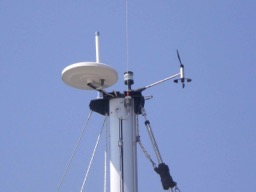
As reported previous, FCC’s delay on this issue, the 2487 days from the CTIA white paper to today’s R&O, was a lose/lose period for both sides.
The BDA manufactures faced serious offshore competition from irresponsible manufacturers who made no attempts to limit interference from their units to cellular systems as well as being denied access to normal capital from the financial community because of the risks involved when the megacorporations that are the 4 major carriers sought to have them driven from the face of the earth! The carriers also faced both continuing interference from early models of BDAs as well as current models from irresponsible manufacturers along with the knowledge that no matter what the new rules say the bad units will continue in use for several more years. THE COSTS OF FCC DELAY!!
CTIA has issued no statement as yet on the R&O while Wilson Electronics, a major manufacturer of this equipment has.
The second item dealt with an expanded “Wi-Fi” band at 5 GHZ. I put Wi-Fi in quotes since it is a registered trademark of the Wi-Fi Alliance which in the past has indicated misgivings about the FCC’s casual use of terms like “super Wi-Fi”. Also the present and probably the new FCC rules do not require the use of only IEEE 802.11 standards in any specific unlicensed bands.
The Commission press release states
The Commission proposed to make up to 195 megahertz of additional spectrum in the 5 GHz band (a 35% increase) available to unlicensed wireless devices. It also proposed to create a more flexible regulatory environment, and to streamline existing rules and equipment authorization procedures for devices throughout this band.
Unlicensed National Information Infrastructure (U-NII) devices today operate in 555 megahertz of spectrum in the 5 GHz band, and are used for short range, high speed wireless connections including Wi-Fi enabled local area networks and fixed outdoor broadband transceivers used by wireless Internet service providers to connect smart phones, tablets and laptops to the broadband network.
The proposed modifications would provide access to additional contiguous spectrum with consistent technical requirements, allowing unlicensed devices to use wider bandwidth channels, leading to faster speeds.
This spectrum current has federal users in parts of it and thus FCC and NTIA share responsibility for it. NTIA has agreed to the NPRM and may modify its position later. In or nearby the promised spectrum are present and planned uses by Intelligent Transportation Systems (ITS). Some members of the ITS community have been comparing this NPRM to the GPS/LightSquared issue although the major ITS trade association, ITS America was quite moderate and open minded in its statement.
The link to NPRM text is now here.
ex parte Enforcement:
$10,000 "Voluntary Contribution" and a "Compliance Plan" in Resolution of a Violation
- Only FCC requires the outside party to file a summary of any face-to-face meeting/telephone call/ and any written documents such as e-mail and depends solely on that filing to document the exchange of information. (Note that some outside parties may see an advantage to “game” the system by delaying or obfuscating public disclosure of points they make to FCC officials
- All other agencies use their staff to summarize the interaction although they include any documents that were presented.
Thus the timely filing of a valid description of the interaction is necessary to fulfill the transparency goals of the FCC’s ex parte rules.
Until January 11, 2011 FCC had never even sent an official violation notice to any outside party for a violation of these rules! All violations were handled informally “between gentlemen” with no public disclosure. Indeed, outside complaints were almost always dismissed also without public disclosure.
The ex parte rule update was adopted on February 1, 2011 and became effective June 1, 2011. In adopting the new procedures the Commission stated:
We will, however, amend our rules to require that the General Counsel refer any case in which a forfeiture or a citation may be warranted to the Enforcement Bureau for disposition and we will delegate authority to the Enforcement Bureau to levy fines for violations of the ex parte rules. In the event the Enforcement Bureau ultimately determines that a forfeiture or a citation is not warranted, the General Counsel will take appropriate action on the matter.
The Docket 10-43 Report & Order gave no legal citation on how the FCC has authority to levy such forfeitures, which your blogger believes exceeds the statutory provisions of Title V of the Communications Act - but, heck, he’s not a lawyer. But it was curious that there was no sign of any such a forfeiture until yesterday.

Over a year ago, FCC sent a letter to the Alaska Railroad Corporation, which is owned by the State of Alaska, stating it had violated the ex parte rules because an employee had sent an e-mail with attachments to an FCC staffer dealing with a rulemaking and both failed to file a copy in the docket and again failed to do so when asked by the FCC staffer. The letter referred the issue to eh FCC’s Enforcement Bureau for “possible action”. Your blogger was curious about this when there was nothing on the public record 9 months later and filed a FOIA request. The request was greeted with quibbling from FCC about his eligibility for FOIA requests without charge and at one point FCC/OGC stated that 9 hours of GS-15 time was needed to comply with this FOIA request! However, in order to simplify and resolve this issue quickly your blogger agreed to narrow the scope of the request and today received a “Valentine’s Day present” of the Consent Decree shown above, dated February 14, 2013.
In the Consent Decree, Alaska Railroad agrees to a 2.5 page “compliance plan” (p. 4-7) and “a voluntary contribution to the United States Treasury in the amount of ten thousand dollars ($10,000)”. Now Alaska Railroad is not a major participant in FCC proceedings, indeed it has not filed anything in ECFS during the past 10 years. Either they are the most wanton violator of ex parte rules or they are a “country bumpkin” outside of the Beltway who rarely deals with any FCC issue. But I guess they were an easy target without a major FCBA member representing them. (While your blogger was an FCC employee, he dealt with such occasional problems of the uninformed without proper representation by simply forwarding the communication that wasn’t filed to the Secretary’s Office and asking that it be filed.) The “compliance plan” doesn’t seem very relevant for such a regulatee that rarely interacts with FCC, but hopefully it will set a precedent for more mainstream players.
So a precedent has been set for fines and compliance plans in case of violations. Someday FCC will lock horns with a violator who will litigate whether Title V provides for such types of fines, but until then parties may find it cheaper to just pay $10,000 if FCC asks. The compliance plan looks like a good idea and if the former AMST was still around I would suggest that its should have such a plan, but MST has been absorbed by NAB which was a clean ex parte record.
DARPA Starts to Tackle Radar/Comm Sharing
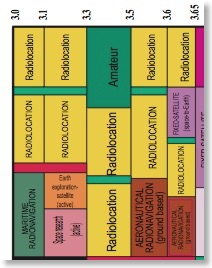
When sharing was proposed, the same IRAC was able to dictate sharing conditions to FCC with the functioning of the radar as originally designed being the paramount issue. Overprotection that limited private sector sharing was of little concern to IRAC and the technical criteria development was often shrouded in secrecy to protect the technical details of the radars involved. This is shown in the case of the 5 GHz U-NII sharing where we have the bizarre sharing conditions of § 15. 407:
According to these 2 sections if an unlicensed device detects any signal on the channel greater than - 64 dBm (non techies: that is less than a millionth of a milliwatt!) it must avoid using that channel for the next 30 minutes! Double checking to see if it is a false alarm due to noise is not allowed by this rule.
§ 15.407(h)(2) Radar Detection Function of Dynamic Frequency Selection (DFS)
A channel that has been flagged as containing a radar system, either by a channel availability check or in-service monitoring, is subject to a non-occupancy period of at least 30 minutes. The non-occupancy period starts at the time when the radar system is detected..Radar Detection Function of Dynamic Frequency Selection (DFS). U-NII devices operating in the 5.25-5.35 GHz and 5.47-5.725 GHz bands shall employ a DFS radar detection mechanism to detect the presence of radar systems and to avoid co-channel operation with radar systems. The minimum DFS detection threshold for devices with a maximum e.i.r.p. of 200 mW to 1 W is −64 dBm. For devices that operate with less than 200 mW e.i.r.p. the minimum detection threshold is −62 dBm. The detection threshold is the received power averaged over 1 microsecond referenced to a 0 dBi antenna. The DFS process shall be required to provide a uniform spreading of the loading over all the available channels…Non-occupancy Period.
A channel that has been flagged as containing a radar system, either by a channel availability check or in-service monitoring, is subject to a non-occupancy period of at least 30 minutes. The non-occupancy period starts at the time when the radar system is detected.
(It is ironic that the recurring interference to NOAA’s TWDR weather radars is not addressed here since TDWR is a doppler system unlike FAA radars. It appears that DoD and FAA dominated the secret IRAC deliberations on the criteria that was dictated to FCC by NTIA and did not pay much attention to NOAA’s radar technology.)
To NTIA’s credit they did choose radar/communications sharing as the theme of the 2011 International Symposium on Advanced Radio Technologies, their annual public technical conference in Boulder CO. The conference was entitled “Developing Forward Thinking Rules and Processes to Fully Exploit Spectrum Resources: An Evaluation of Radar Spectrum Use and Management”. In the proceedings, is a paper (p. 214) from your blogger entitled “Thoughts on Radar/Communications Spectrum Sharing”. This paper breaks from the static precedent of U-NII radar sharing and suggested time dynamic sharing, noting that while 1000 ms/s spectrum access was essential when circuit switched voice dominated mobile traffic, today’s packet switched data is the dominant traffic and packet switching technology can readily make reliable networks our of time intermittent links.
The paper was discussed at the conference and here are two comments from the proceedings:
A second idea that is very important, first advocated for by Michael Marcus, is about unlicensed low power uses and it has spawned a revolution of technological developments that take advantage of that possibility. -- Phil Weiser, U. Colorado (Formerly senior advisor for technology and innovation to the National Economic Council at the White House)
I also wanted to take just a minute to recognize that Mike Marcus, who was originally going to be on this panel but couldn’t make it in the end, also put together a paper that talks about some sophisticated techniques for sharing with radars. -- Julius Knapp, FCC
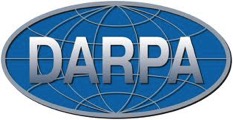
The purpose of this conference is to provide information on the SSPARC program; promote additional discussion on this topic; address questions from potential proposers; provide a forum for potential proposers to present their capabilities for teaming opportunities; and following the conference, conduct pre-scheduled one-on- one meetings with the Program Manager as described below.
PROGRAM OBJECTIVE AND DESCRIPTION: DARPA anticipates releasing the BAA for SSPARC with the objective described in this section. The objective of the SSPARC program is to improve radar and communications capabilities through spectrum sharing. SSPARC develops technology applicable to spectrum sharing between military radars and military communications systems, and between military radars and commercial communications systems. SSPARC includes work on spectrum sharing systems and separation mechanisms, supporting technologies that improve performance when sharing spectrum, theoretical performance limits and grounded design techniques, and relevant regulatory topics.
It is gratifying to see that this concept is moving along towards more detailed study after being ignored for a long time.
Now if only the cellular industry would address the topic of using intermittent access to radar spectrum fro CMRS with an open mind rather than insisting on an unrealistic goal of meeting all their spectrum demands solely by reallocation.
UPDATE
The DARPA BAA is now posted here. From the introduction:
The Shared Spectrum Access for Radar and Communications (SSPARC) program seeks to improve radar and communications capabilities through spectrum sharing.
Spectrum congestion is a growing problem. It increasingly limits operational capabilities due to the increasing deployment and bandwidth of wireless communications, the use of net-centric and unmanned systems, and the need for increased flexibility in radar and communications spectrum to improve performance and to overcome sophisticated countermeasures. Radar and communications jointly consume most of the highly desirable spectrum below 6 GHz. SSPARC seeks to develop sharing technology that enables sufficient spectrum access within this desirable range for radar and communications systems to accomplish their evolving missions.
The SSPARC program seeks to support two types of spectrum sharing.
- Spectrum sharing between military radars and military communications systems (“military/military sharing”) increases both capabilities simultaneously when operating in congested and contested spectral environments.
- Spectrum sharing between military radars and commercial communications systems (“military/commercial sharing”) preserves radar capability while meeting national and international needs for increased commercial communications spectrum, without incurring the high cost of relocating radars to new frequency bands.
UPDATE 2/26/13
Today’s public meeting on the DARPA BAA was a great success with about 150 people present! There clearly is great interest in the topic in the R&D community.
Is there any interest in using such spectrum from the cellular establishment or will they continue their negative reaction to the PCAST report and demand 500 MHz of new spectrum subject to
- nationwide availability
- 24/7 1000 ms/s availability
- compliance with 3GPP band plans?
But as the PCAST report points out this is an unrealistic goal in a country with the largest most information intense military in the world. The cellular industry aimed too high in the “booster amplifier” rulemaking, Docket 10-4. Should they be more reasonable here?
UPDATE 3/15/13
 The SSPARC program now has the logo shown at left. It carefully does not show any physical system in order to be open minded about possible designed. DARPA has now posted on their website presentation from the Proposer’s Day. Of particular interest is a presentation from DoD spectrum managers showing how much spectrum is used by radar today.
The SSPARC program now has the logo shown at left. It carefully does not show any physical system in order to be open minded about possible designed. DARPA has now posted on their website presentation from the Proposer’s Day. Of particular interest is a presentation from DoD spectrum managers showing how much spectrum is used by radar today.That CTIA Flag Chart

For at least 2 years CTIA has been using the above chart, including minor variations, as part of its justifications for more allocations for cellular licensees. Your blogger does not disagree with the basic need for such allocations.
But it is interesting to look at the logic of this chart. Note the 3rd row “Efficient Use of Spectrum -- Subscribers Served per MHz of Spectrum Allocated”. In the US the value is 809,722 while in Spain it is on 92,960. Wow, Spain must be a great place!
Now let’s extend this logic. Let’s take the CIA World Factbook as a source of population data. Vatican City has a population 826 and has the same 375 MHz cellular allocation as Italy, so it has an “Efficient Use of Spectrum” of 825/375 or 2.2. They must have great cellular connectivity! Cellular nirvana.
How about San Marino, population 32,140 with an “Efficient Use of Spectrum” of 85.7 Supernirvana!
Click map to enlarge
Think these are too obscure? Luxembourg is a founding member of NATO and has a population of 509,074, giving an “Efficient Use of Spectrum” of 1358. So if you want great mobile service and don’t want the limits of living in the Vatican or San Marino, move to Luxembourg! (I’ve been there! The local wines are also great.)
The real point is that spectrum efficiency really is important. But spectrum lobbyists are reducing arguments to absurdity by trivializing technical issues in the high stakes game of spectrum allocations. It is amazing that CTIA has used this nonsensical metric for so long and it reflects on both CTIA and many of the government officials they deal with that they have been able to use such garbled thinking for so long.
Spectrum efficiency is generally thought of including more than population and amount of spectrum, area is a key issue. Frankly, it doesn’t make much sense to deal on spectrum efficiency with a country as a whole, since demand varies greatly in different areas in countries larger than Vatican City. A much better metric is peak population/area/MHz.
Now maybe this is too confusing for spectrum lobbyists and the officials that they deal with, but misleading information like the “flag chart” detracts from the real issues.
Can’t we have a spectrum dialogue with real facts, not phony metrics made up by spectrum lobbyists and PR firms?
California Report on Prison Cell Phone Use Issues
As of July 2008, seventy-six members and fellows are also members of the National Academies, six are Nobel laureates, nine are National Medal of Science recipients and two are recipients of the National Medal of Technology.
CTIA and the major cellular carriers believe that Section 333 of the Communications Act precludes FCC from authorizing jamming of cellular communications by private sector or state or local government officials. The meaning of Section 333 has been a recurring topic here. While NTIA appears to agree with the cellular industry in this interoperation of the section, it appears that FCC has never made an en banc finding on this interpretation of the law although it is clear that under present FCC rules jamming is not authorized.
The CCST report describes managed access as:
“The Managed Access System (MAS) refers to a standard cell phone network system used in a defined close quarter geographic area such as a campus, military base or a prison. The theory behind MAS is to allow authorized cell phones to connect to the standard carrier (e.g. AT&T, Sprint, T-Mobile,Verizon) networks, while preventing unauthorized cell phones from connecting to the carrier networks. A well-designed and implemented MAS would function as a system to detect and preclude the operation of cell phones not authorized in the MAS approved database.”
CTIA and NTIA both feel that “managed access” is an effective technology for controlling cell phone use in prisons and the resulting threat to public safety. The CTIA website has the quote shown at left clearly describes managed access as “proven technology”. However, the December 2010 NTIA repot mandated by Congress does not go as far as CTIA does in saying that managed access is “proven”. NTIA merely states that “Managed access technologies hold promise as a solution” (p. 37) and that “(t)he technology requires close coordination with the FCC and wireless carriers”. NTIA also raised questions about the cost of managed access.
In contrast to CTIA’s confidence in managed access and NTIA’s optimism, CCST finds
“(T)he Managed Access System (MAS) technology of today is not mature enough for immediate large-scale deployments such as that proposed by CDCR at California’s 33 state prisons.”(p.6)
Readers who followed the Linkedin Spectrum Experts group discussion on the NTIA report may recall that Australia’s Barry Matson suggested the solution may be putting the burden on the cell operators to not connect calls from cell phones in prisons. The report independently comes to a similar suggestion:
The CCST Project Team recommends that potentially useful technology approaches be explored in confined prison areas, and that cell phone carriers be engaged to explore options of denying connections for ‘unregistered’ cell phones within prison locations using the carriers’ technology. In this latter case, identity of illegal cellular phones could be obtained via a benchmarking technology and the carrier could then deny cellular connection to the specific unregistered devices. Engaging the carriers would likely require either a legal requirement to participate or an income incentive via fee for participation. With the recent agreement of cell phone carriers with the federal government to disable services on stolen cell phones, this approach should be explored.
But even if managed access is ever to be used on a large scale it needs a better policy foundation than FCC just condoning its use. Successful managed access requires both the active participation of all the cellular carriers near a prison and detailed coordination of any technical changes to the cellular network including introduction of changes in the physical layer of the RF signal as well as new services. A successfully operating managed access system can become useless overnight and endanger public safety if one of the cellular systems in the area has an unanticipated technical change. While the major cellular carriers have indicated a willingness to accept managed access systems and sign agreements with prison authorities, they have never stated that would coordinate all technical changes and delay them as necessary until the managed access systems were upgraded. In addition, the 4 major cellular carriers are not the only carriers in the country, especially int he rural areas where maximum security prisons are often located. Indeed, future cellular auctions could well result in more corporate diversity. CCST finds
“A coordinated effort of several states to petition the FCC to modify existing spectrum owners’ agreements to require they provide unobstructed use of their spectrum within the geospatial confines of corrections facilities would be an important modification of regulations. If this effort is undertaken, the discussions could also include the possibility of using jamming technologies in some conditions.”
While the mainstream cellular industry is enthusiastic about managed access because it may allow jamming to be kept in Pandora’s Box, they have never taken a more positive step to build the policy infrastructure needed to give managed access a fair chance of success, whether or not that is really possible in the technical sense.
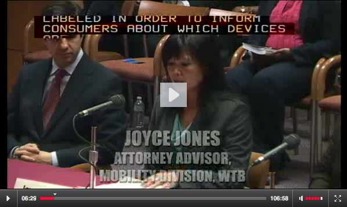

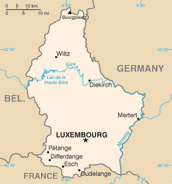
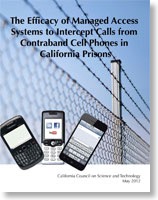
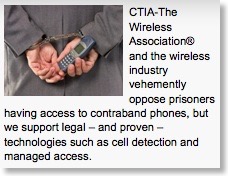



![Validate my RSS feed [Valid RSS]](valid-rss-rogers.png)

